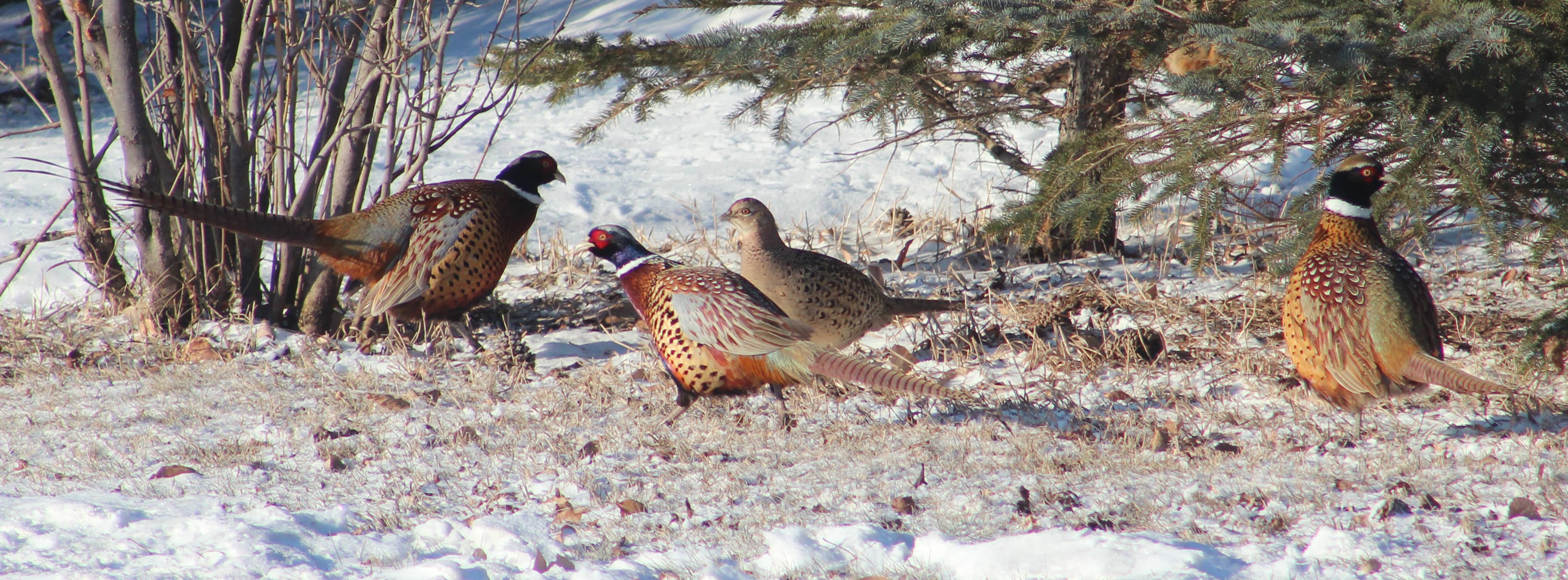
Outnumbered. While it might seem counterintuitive, taking a few late season rooster pheasants does not have any impact on how next fall’s bird populations will shape up. Simonson Photo.
By Nick Simonson
It might seem like pheasant numbers are down in certain areas as the season approaches its end, and people may be inclined to assume that by not hunting roosters in these final weeks that they may be helping preserve populations for next season.
That’s likely not the case, however, and to the contrary, removing some of those late season roosters now may be good for next year’s populations. So, if you’re thinking about holding off on hunting the upper Midwest’s favorite upland bird because they seem scarce, or a hunter calls to ask permission to walk your acres, consider the following facts that show late season hunting won’t hinder the populations next season.
Foremost, hen populations in any given area are what determine whether or not there will be enough reproduction in spring to sustain good hunting the following fall. Since hunting seasons throughout the upper Midwest allow only the taking of rooster pheasants, their removal from the population at this point late in the season by hunters has no impact on how numbers will turn out the following year. Concern about removing those colorful male birds through hunting should be pushed out of the mind of any hunter or conservationist, according to RJ Gross, Upland Game Biologist for the North Dakota Game & Fish Department (NDG&F).
“We lose 75 percent of our roosters every year,” Gross states, explaining that rooster pheasants die from hunting, natural predation or exposure and suggests that the survival of hens is generally higher, as they go unhunted and do not have that pressure, adding, “you need to be worried if you don’t see hens; hens are what drive the populations – not the roosters – which is why we don’t shoot hens, and that’s proven by a ton of scientific research.”
Additionally, studies from around the upper Midwest have shown that the average lifespan of a pheasant is approximately one year, with roosters living on average slightly less than that, and hens just a little bit longer, approximately 16 months or so. This disparity in lifespan allows hens to beget the next generation at least once after they’re born, on average, and since the species is polygamous, one rooster is all it takes for a number of hens to successfully mate in the spring. Roosters remain the dispensable part of the equation, and as a result, hunters shouldn’t feel guilty about harvesting them heading into winter, even when it seems they’re limited.
“Roosters are not monogamous like humans are, they have up to 10 hens that they can service every year,” Gross states of how few males are actually needed to continue to provide huntable populations, suggesting instead that hunters and landowners keep an eye out for bird ratios over the winter and early spring to get a guess as to how next fall will be, “in the good years, one rooster for five or six hens was our best ratio,” he concludes, referencing back to 2007 when pheasant numbers peaked.
What’s more, in those harsh winters or seasons where access to food is lacking, roosters can provide unwanted competition for hens. When snow covers up fields or limits areas of forage, the more aggressive male birds can cause headaches for hens looking to stay healthy through the winter.
“Roosters will kick the crap out of hens to get them away from a food source…when it comes down to it, they’ll bully them,” Gross relates of those tough winters where the more aggressive males will strive for survival even over their mates, “when food’s limited, it’s a survival of the fittest kind of thing,” he continues, adding that the impact of the competition on hen health is likely minimized as the birds can move to other feeding areas.
What is concerning, however, is the continued disappearance of habitat on the landscape coupled with a shift in demand for extended pheasant seasons. These colliding factors would negatively impact pheasant populations the further north one goes in the birds’ range. With January typically the most brutal month in terms of snow and cold temperatures, pheasants require a good deal of sedentary seclusion in thermal cover, and having hunters roust them from their hiding places and create added stress would have a noticeable impact on the health of hens and their numbers coming into spring.
“South Dakota worries me and I know North Dakota wants it – and we got asked a few times during our Advisory Board meetings – that people want to extend the season through January, and that worries me more,” Gross says of the recent extension of the pheasant season in the Rushmore State, cautioning: “if we’re hunting in January and we’re going to kick them out of their winter cover and their winter food and expose them more to the elements, that could have a way bigger impact on their condition.”
As for those last remaining pheasant hunts, no matter if numbers are up, down or the same in a particular area as last year, hunters need not feel guilty for bagging a few extra roosters headed into the holidays and landowners can rest assured that as long as there are hens there will be more birds next fall. The impact the late season harvest has on the overall population is zero and it just might help prevent some hen harassment and keep ratios better for spring reproduction.
So, get out there and enjoy the opportunity, because while things have been nice thus far in the late season, one never knows when winter will decide to arrive in the northern stretches of pheasant country.
